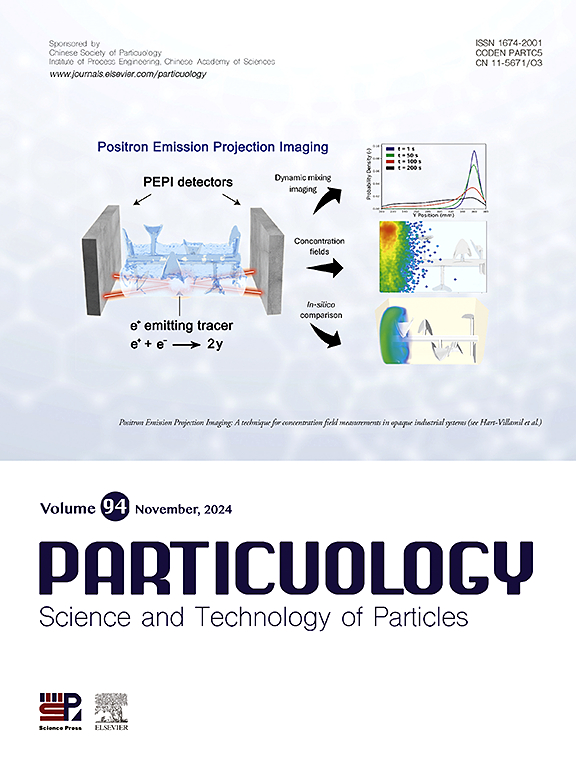基于机器学习模型的三元重介质流化床油页岩分离床层密度分析与预测
IF 4.3
2区 材料科学
Q2 ENGINEERING, CHEMICAL
引用次数: 0
摘要
在高密度气固流化床中,低品位油页岩的高效干式选矿需要对床层密度进行精确调节。本研究开发了由硅铁粉、磁铁矿粉和油页岩颗粒组成的三元致密介质体系,并研究了介质组成、流体力学和机器学习辅助密度预测之间的耦合关系。结果表明,三元密度调节策略显著提高了干式重介质流化床的流化均匀性和分离效率。当油页岩质量分数从0%增加到20%时,临界流化速度从12.54 cm/s增加到14.08 cm/s,床层膨胀率从5.19%增加到8.83%。与常规二元介质相比,三元体系将平均床层密度从2.567 g cm−3降低至2.382 g cm−3,在最佳油页岩质量分数为8%时,密度波动最小(标准差SD = 0.097)。采用遗传算法优化的反向传播神经网络(GA-BP)利用7个过程特征预测了167个样品的床层密度,相关系数R = 0.979,均方根误差(RMSE)为0.049,比传统BP模型误差降低18%。因此,所提出的三元介质策略和GA-BP预测器为稳定、节能的油页岩干分离提供了一个强大的框架。本文章由计算机程序翻译,如有差异,请以英文原文为准。

Bed density analysis and prediction of ternary dense medium fluidized bed for oil shale separation using machine learning modeling
Efficient dry beneficiation of low-grade oil shale requires precise regulation of bed density in high-density gas–solid fluidized beds. This study develops a ternary dense-medium system comprising ferrosilicon powder, magnetite powder and oil shale particles, and investigates the coupling between medium composition, hydrodynamics and machine-learning-assisted density prediction. The results demonstrated that the ternary density regulation strategy significantly enhances fluidization uniformity and separation efficiency in the dry dense-medium fluidized bed. When the oil-shale mass fraction increases from 0 % to 20 %, the critical fluidization velocity rises from 12.54 to 14.08 cm/s, while the bed expansion ratio grows from 5.19 % to 8.83 %. Compared with the conventional binary medium, the ternary system lowers the mean bed density from 2.567 to 2.382 g cm−3 and achieves the minimum density fluctuation (standard deviation, SD = 0.097) at an optimal oil-shale mass fraction of 8 %. A back-propagation neural network optimized by a genetic algorithm (GA-BP) using seven process features predicts bed density with correlation coefficient R = 0.979 and root-mean-square error (RMSE) of 0.049 on 167 test samples—an 18 % error reduction over the conventional BP model. The proposed ternary medium strategy and GA-BP predictor therefore offer a robust framework for stable, energy-efficient dry separation of oil shale.
求助全文
通过发布文献求助,成功后即可免费获取论文全文。
去求助
来源期刊

Particuology
工程技术-材料科学:综合
CiteScore
6.70
自引率
2.90%
发文量
1730
审稿时长
32 days
期刊介绍:
The word ‘particuology’ was coined to parallel the discipline for the science and technology of particles.
Particuology is an interdisciplinary journal that publishes frontier research articles and critical reviews on the discovery, formulation and engineering of particulate materials, processes and systems. It especially welcomes contributions utilising advanced theoretical, modelling and measurement methods to enable the discovery and creation of new particulate materials, and the manufacturing of functional particulate-based products, such as sensors.
Papers are handled by Thematic Editors who oversee contributions from specific subject fields. These fields are classified into: Particle Synthesis and Modification; Particle Characterization and Measurement; Granular Systems and Bulk Solids Technology; Fluidization and Particle-Fluid Systems; Aerosols; and Applications of Particle Technology.
Key topics concerning the creation and processing of particulates include:
-Modelling and simulation of particle formation, collective behaviour of particles and systems for particle production over a broad spectrum of length scales
-Mining of experimental data for particle synthesis and surface properties to facilitate the creation of new materials and processes
-Particle design and preparation including controlled response and sensing functionalities in formation, delivery systems and biological systems, etc.
-Experimental and computational methods for visualization and analysis of particulate system.
These topics are broadly relevant to the production of materials, pharmaceuticals and food, and to the conversion of energy resources to fuels and protection of the environment.
 求助内容:
求助内容: 应助结果提醒方式:
应助结果提醒方式:


